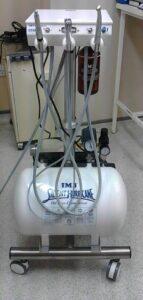Buddy
Buddy, a 4 year old Pomeranian had a swelling under his left jaw area which had been present for a few weeks. The hair was clipped and a thick, syrupy liquid was removed and sent for laboratory analysis and it proved to be saliva. Buddy was diagnosed with a salivary mucocoele; a soft, fluidy swelling filled with saliva as a result of a damaged salivary duct. The saliva irritates the tissues causing inflammation and accumulates under the skin.
Buddy had surgery to remove his left mandibular salivary gland and the mucocoele. A drain was used to allow any fluid to drain from the wound. This was removed five days later and he was doing well. There was some puffy swelling in the area which disappeared by the time Buddy had his sutures removed and by then he was back to normal.
New Dental Equipment
City Vet has recently taken delivery of a dental X-ray machine and a newhigh speed dental drill. The dental X-ray machine allows us to take x-rays of cats and dogs teeth. Examination ofthe roots to identify disease below the gum line is a very useful tool as up to 40% of pets dental problems can only be diagnosed by x-ray.

Dental problems are much more common in elderly patients where reducing anaesthetic time and reducing the risk of complications is very important. The time saved with these dental techniques, along with an ECG to monitor the heart and oxygen levels in the blood, significantly increases safety in these patients and allows us to give elderly cats and dogs with dental disease a lot more comfort. Sadly many pets are unknowingly allowed to have dental pain which adversely affects their quality of life because owners are often not aware of the pain or may be anxious about anaesthetic and surgery to treat dental disease in an older pet.
